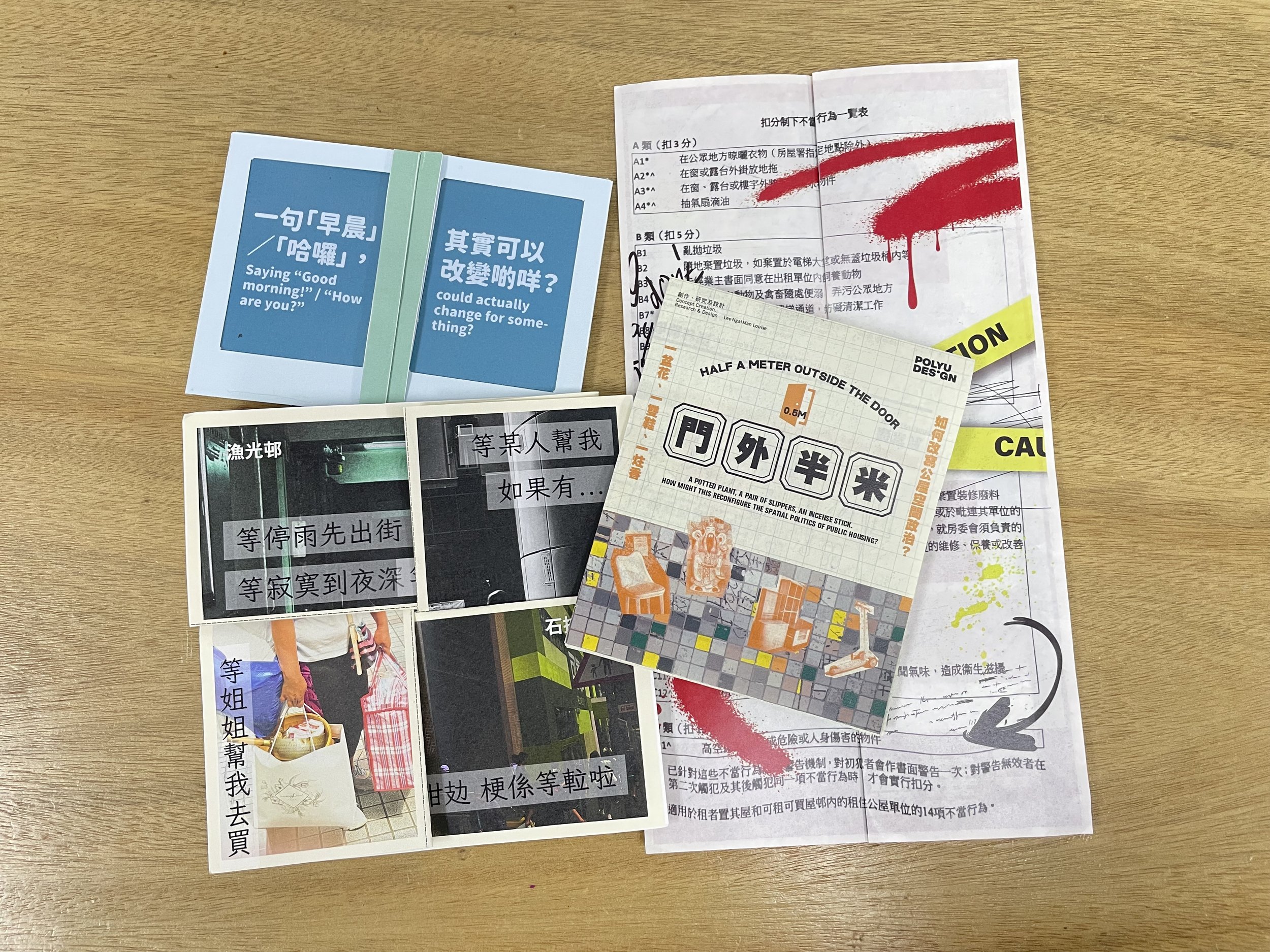南區公屋邨考察備亡@ by 社會計設系學生 Tabloids of Exploration in Southern District Public Housing Estates, by Social Design Students
( Scroll Down for English)
南區有不少在建於1960年代的公屋邨,幾代人生活及成長其中,留下很多生活痕跡和智慧,而且會隨時間不斷發酵、改變,成社區生活和發展的考現現場。
這些來自社會設計學系學生創作的小型刊物,內容有關他們到訪漁光邨、石排灣邨及華富邨考察的過程,從觀察當中發掘自己感興趣的角度,觸及民間設計、公私空間運用,還有當中所指涉出的權力與制衡等等的主題。
很多時我們看待舊社區、屋邨的關係,包括人與人之間的,人與動植物或人與地方的,很多時會用一種「人情味」的視角來包攬,而同時好像「只有情」或「只能說情」,甚至當這些情都是在消退之中時,我們就只能婉惜與懷緬。反之,若能從帶着其他的視覺,如建築、設計、人類學、城市發展等去爬梳當中的「非物質(瀕危)遺產」,或者能找到一些建立那些「人情味」的端倪——更理想的,是捉到一些法子可以用在未來社區發展中。
這幾份刊物的內容,簡述了各人就着到訪屋邨的觀察與分析,雖然篇幅不長,但點題出他們各自關心的角度背後,所指涉出的一些社區價值和當中無形的秩序。
#社會設計 #社區設計#socialdesign #華富邨 #漁光邨 #石排灣邨
《如果...我是長者生活在漁光邨》
對照香港仔與漁光邨街市人流差異,還有兩邨老人家拉手推車的習慣,了解兩邨的街市發展及暢達度不同。
《門外半米:一盆花、一雙鞋、一炷香,如何改寫公至空間政治?》by 李藝文
從華富邨各單位外那不過半米的「灰色空間」 ,反映居民有機性的空間實踐。
《一句「早晨」 「哈囉」,其實可以改變啲咩? 》by Kwok Tsz Ki
從漁光邨的密集住宅單位佈局及塑造出的緊密鄰里關係下,發揮到的社群連結功能。
********
此為臨時庫存館藏亦不擁有藏品的版權,歡迎到訪查閱。
********
In the Southern District, there are numerous public housing estates built in the 1960s. Generations have lived and grown up in these estates, leaving behind traces of life and wisdom. Over time, these traces continue to ferment and evolve, becoming a "living record" of community life and development.
These small publications, created by students with backgrounds of Social Design, document their visits to Yue Kwong Chuen, Shek Pai Wan Estate, and Wah Fu Estate in Aberdeen. Through on-site observations, the students explored topics which they were interested about, touching on themes such as grassroots design, the use of public and private spaces, and the dynamics of power and balance embedded within the community.
When we think about old communities and housing estates, including the relationships between people, people and nature, or people and place, we often view them through the lens of "human warmth." It’s as though everything can only be explained by emotions or nostalgia. And when these emotions inevitably fade, all we are left with is regret and reminiscence. However, if we adopt other perspectives—such as architecture, design, anthropology, and urban development—to examine the "intangible (and endangered) heritage" within, we might uncover the roots of this "human warmth." Ideally, we could even develop methods to apply these insights to future community development.
The content of these publications briefly summarises the students' observations and analyses during their visits to the housing estates. Although the publications are concise, they highlight the community values and the invisible order behind the angles of concern that each student focuses on.
"If... I Were an Elderly Person Living in Yue Kwong Tsuen”
By comparing the differences in foot traffic between the wet markets of Aberdeen and Yue Kwong Estate, as well as the habits of elderly residents pulling trolleys, the publication examines the development and accessibility of the markets in the two areas.
"Half A Meter Outside The Door: A Potted Plant, A Pair of Slippers, An Incense Stick. How Might This Reconfigure The Spatial Politics of Public Housing?"by 李藝文
Examining the "grey space" outside every residential unit in Wah Fu Estate, this work reflects residents’ spatial practices.
‘Saying “Good morning!”/ “How are you? Could actually change for something?” ’ by Kwok Tsz Ki
Focusing on the dense layout of residential units in Yue Kwong Tsuen and the close-knit neighbourhood relationships it fosters, this publication explores the functionality of community connections.
#socialdesign #communitydesign #wahfuestate #yuekwongtsuen #shekpaiwanestate
****
The archive does not necessarily hold the copyright to its collection items. Welcome to visit us for book access.
****



